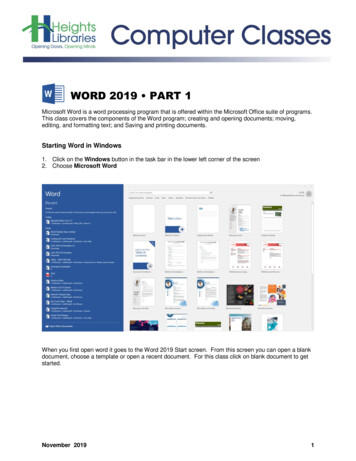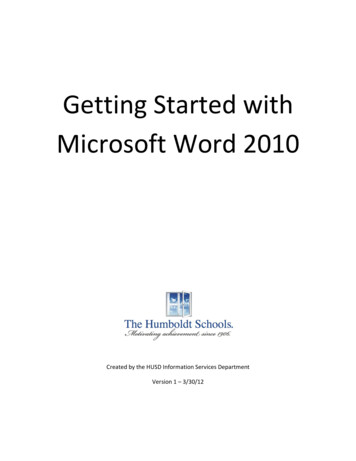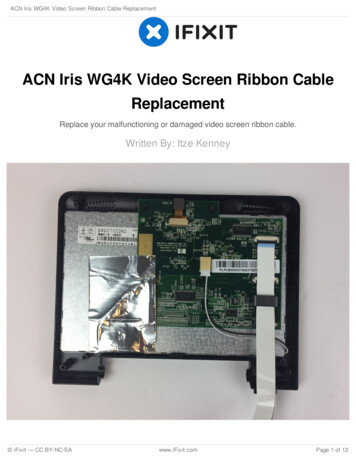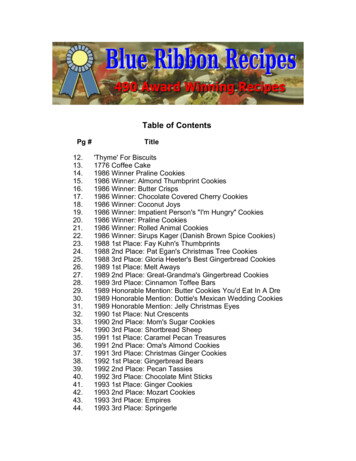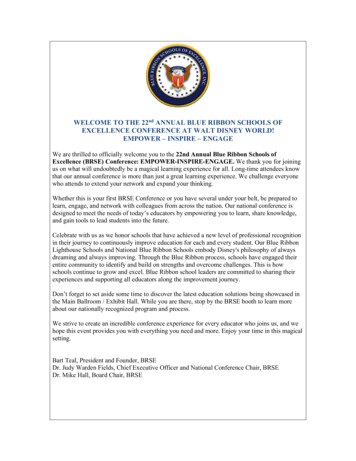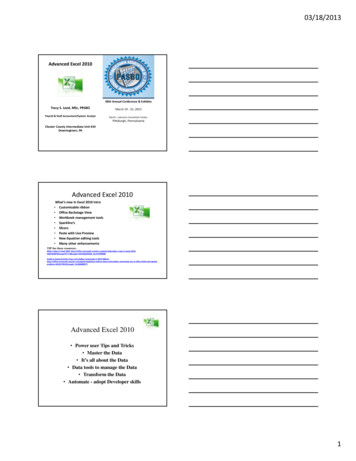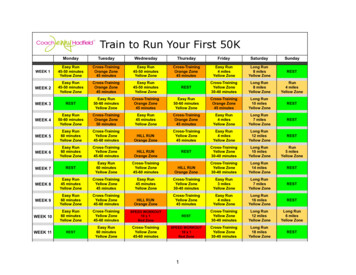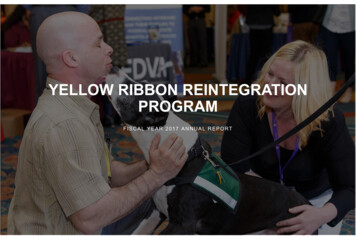
Transcription
YELLOW RIBBON REINTEGRATIONPROGRAMFISCAL YEAR 2017 ANNUAL REPORT
WELCOME TO THE FISCAL YEAR 2017 YELLOW RIBBONREINTEGRATION PROGRAM ANNUAL REPORTMESSAGEDirector, Office for Reintegration ProgramsIn establishing the Yellow Ribbon Reintegration Program (YRRP) 10 years ago, Congress recognizedthat National Guard and Reserve Service members face challenges throughout the deployment cyclethat are uniquely different than those confronting their active duty counterparts. Most notably, NationalGuard and Reserve Component (RC) Service members often live far from military installations andother members of their units, diminishing their opportunities for support from military bases andpersonnel during each stage of deployment.RC members are the backbone of our Nation’s military, comprising nearly half of our total force. Wehave relied on them to offset strains within the active duty force in support of combat missions abroadand will continue to rely on them in the years to come. Nearly one million Guard members andReservists have deployed since September 11, 2001, with nearly 33,000 mobilized as of January 1,2018.RC members not only support combat operations, security, and humanitarian missions around theworld, they also ensure our safety when unforeseen disasters and emergencies occur. Just this pastfiscal year, RC members have responded to Hurricanes Harvey, Irma, and Maria, providing relief andemergency services to hundreds of thousands of affected Americans. Their compassion,professionalism, and courage continually safeguards our way of life abroad and at home.
YRRP addresses the challenges facing RC members and their families byconnecting them with resources where they live and providing a network to supporttheir unique circumstances. Through the program, they gain access to relevantinformation and resources, including family and marriage counseling, financialplanning and education, small business planning, legal benefits, healthcareinformation, employment training opportunities, and veteran’s benefits education.Between January 28, 2008 and October 1, 2017, YRRP pre-, during, and postdeployment events have supported more than 1.7 million RC members and theirfamilies. The Post-Event Survey data indicates that attendees overwhelmingly reportthe events as being helpful. In fact, YRRP events havereceived an 82 percent or higher satisfaction rate through fiscal years (FY) 2014,2015, 2016, and 2017. In addition, YRRP is continually evolving to address thechanging needs of a dynamic and diverse military community.These 10 years demonstrate the critical and enduring nature of the YRRP. Thisprogram remains committed to maintaining the readiness of National Guard andReserve Service members, their families, and their communities to enhance thecapacity and lethality of our nation’s military force.COL Donna McDermottDirector, Office for Reintegration Programs
OVERVIEWThe Yellow Ribbon Reintegration Program (YRRP) is a joint-Service effort led by theOffice of the Assistant Secretary of Defense for Manpower and Reserve Affairs andadministered by the Defense Personnel and Family Support Center’s Office forReintegration Programs (ORP). In 2008, Congress directed the Secretary of Defenseto establish YRRP in Section 582 of Public Law (PL) 110-181 in direct response to theNation’s recognition of the unique challenges facing the Reserve Component (RC)community. These challenges include:Understanding and accessing benefits earned as a result of activationGeographic isolationDisparate or sparse access to military family support groups in local communitiesContinued and repeated deployments (as of Oct. 17, 2017, 32,654 RC members wereactivated, and nearly 960,000 had been activated since Sept. 11, 2001)Unemployment and underemployment of returning RC members
SECTION 582 OF PL 110-181 ALSO DIRECTS YRRP TO:Provide education and ensure the readiness of Service members, their families, and affected communities for the rigors of deploymentImplement reintegration curriculum throughout the deployment cycle that builds resilience for current and future deploymentsEducate Service members and their families about the resources available, and connect members to service providers who can assist them inovercoming the challenges of reintegrationIn FY 2017, RCs conducted more than 800 YRRP events, directly affecting 91,232 Service members and their families. YRRP has supported more than 1.7million Service members and families since the program’s inception in 2008. YRRP’s continued dedication to sharing and evaluating resources, tools, andbest practices in coordination with each of the seven RCs has led to an event satisfaction of 82 percent in FY 2017 (see Figure 1). YRRP initiatives continueto be developed and implemented through coordination with each of the RCs as they support RC members and their loved ones throughout and beyond thedeployment cycle.Figure 1: FY 2017 YRRP Event Satisfaction
HIGHLIGHTSAs emerging technologies continue to change the way people live, learn, and work, YRRP is focused on improving program tools to enhance its offerings andcapabilities. From online registration and automated agenda creation to live-polling and digital information and resources,YRRP is leveraging new and innovative technological solutions to increase efficiency and enhance event delivery, impact, and feedback.EVENTPLUSThroughout FY 2017, YRRP worked hand-in-hand with the RCs to develop new tools supporting EventPLUS, YRRP’s online event management solution. Someof the key EventPLUS updates include:SMS Live-Polling: SMS Polling is an interactive polling tool using text messagingtechnology to gauge the audience’s knowledge on key topics just before and after the event.This tool allows YRRP and the RCs to better understand needs, and subsequently deliverrelevant content to address that need. SMS live-polling promotes interactivity among RCmembers and their family while providing real-time feedback to event planners during anevent.SMS Breakout Evaluations: SMS Breakout Evaluations use two-way SMS technologies tosolicit quantitative and qualitative feedback quickly from event attendees. This reduces thetime it takes the participants to complete paper-based surveys and reduces printingrequirements.Agenda Builder: This tool provides YRRP staff with the ability to publish and print astandardized event agenda booklet for participants, tailored specifically for each event andRC. The printed agenda booklet will soon have a companion online version for anytime,anywhere access by RC members and their guests before or during an event.
BEYOND THE YELLOW RIBBONBeyond the Yellow Ribbon (BYR) supports programs that are intended to provide critical outreach and reintegration services to RC members and their families.BYR funding is provided through ayear-to-year appropriation approved by Congress. BYR is essential for building and maintaining a myriad of locally-based programs that build sustainablecommunity support networks and connect and coordinate organizations, agencies, and companies to provide resources and support to RC Service membersand their families.In FY 2017, these programs supported RC members returning from deployment through a variety of much-needed services, such as employment counseling,behavioral health counseling, and suicide prevention. These services were developed and used across 15 states, California, Colorado, Florida, Georgia,Indiana, Kansas, Nevada, New Hampshire, North Carolina, Ohio, Oregon, South Carolina, Tennessee, Vermont, and Washington.
SERVICE MEMBER AND FAMILY READINESSService Member and Family Readiness (SMFR) is an activity within ORP that promotes and synthesizes military family readiness, community capacity building,and psychological health programs that prepare and enable RC members and their families to effectively navigate the challenges of military service.In FY 2017, SMFR advanced several initiatives enhancing the readiness and resiliency of RC Service members and their families through outreach, advocacy,awareness, and access to needed services:Facilitated the final year of the Council on Accreditation (COA) Family Programs contract. COA is a national accrediting “third-party” body that formallyevaluates, verifies, and validates military and family service programs and providers against rigid Department of Defense (DoD) and services accreditationstandards. To date, 62 National Guard and Army Reserve programs representing 641 sites have been accredited, with eight National Guard programs and 55sites remaining to be accredited before the program ends in September, 2018Planned, organized, and implemented the 2016 Reserve Family Readiness Awards Ceremony, recognizing the top unit in each of the seven RCs forinnovative family readiness efforts supporting unit mission readiness. The award program, hosted by the Assistant Secretary of Defense for Manpower andReserve Affairs, promotes Service excellence, builds strength in unit-level family readiness efforts, and helps ensure the deployment and mission readiness ofNational Guard and Reserve unitsParticipated in numerous DoD and other working groups to ensure family readiness programs effectively met the unique immediate and long-term needs ofRC members and their families. Team members identified and provided a recommendation to correct a deficiency related to the “opt-in” date for NationalGuard and Reserve drill status officers in the Blended Retirement System (BRS), ensuring all newly accessed National Guard and Reserve officers had fullopportunity to evaluate and select their BRS optionsConducted research and provided referral contact information that helped ensure appropriate use of evacuation assistance funds by the National Guard afterHurricanes Irma and Maria. To help ensure RC members and their families had the fullest and most immediate access to information specific to the NationalGuard and Reserves, the SMFR staff evaluated the Military OneSource beta website, and recommended the establishment of a “Guard & Reserve” button toprovide “one-stop shopping” for RC-unique informationParticipated in the DoD Total Force Fitness Capabilities Based Assessment and numerous other wellness programs, providing perspective andrecommendations to better respond to differences in duty status, geographic separation from units, and other unique psychological and behavioral healthneeds of National Guard and Reserve Service members and their families
PROJECT Y.E.S!Project Youth Extension Service (YES) is a national service program engaging collegestudents in service to meet the needs of military families facing deployment. Specifically,Project YES expands the youth resources of YRRP and provides opportunities for studentsto give back to their communities and country through a year of service while receivingacademic credit.Students who become Project YES staff interns receive first-class youth developmenteducational and facilitation skills, as well as gain valuable experience in programmanagement. With these skills, interns travel the nation delivering specialized youthdevelopment programs to children and youth of deployed family members. To date, ProjectYES has produced 120 interns who have served more than 21,000 youth in 49 states, 4U.S. territories, and Germany (see Figure 2).Figure 2: Annual Attendance and Annual Events, Project YES
Figure 3: Youth Evaluation/Youth Satisfaction, Project YESCADRE OF SPEAKERSThe Cadre of Speakers (Cadre) is comprised of a pool of highly effective and qualifiedpresenters and facilitators who deliver DoD curriculum at YRRP events. The Cadre beganin FY 2010 in order to assist RC training, event planning, and curriculum requirements. InFY 2017 alone, the Cadre supported 366 YRRP events, impacting an estimated 75,000RC members and their families.Members of the Cadre undergo training in presenting DoD-approved curriculum to RCmembers and their families prior to deployment, during deployment, and upon theirtransition from deployment to their civilian lives. Curriculum presentation topics includemental health, suicide
awareness, financial literacy, stress reduction, traumatic brain injury, posttraumatic stress, and other subject-areas representing the most significantchallenges affecting the RCs. Equally important, the Cadre assists YRRP inreviewing, editing, and developing new curriculum based on attendee feedback,collecting curriculum and break-out session surveys for program enhancement,and participating in event planner training events in order to standardize andimprove YRRP program delivery across the RCs.EVENT PLANNER TRAININGIn an effort to increase standardization and consistency of program delivery acrossthe RCs, YRRP conducted an event planner training in Denver, Colorado, July19-21. More than 45 event planners representing all the RCs participated in thethree-day event.Event planners were paired with members of the Cadre of Speakers who facilitatedtable-top discussion and activities, and subject matter experts delivered trainingbriefs on a variety of topics, such as EventPLUS, SMS live-polling, and agendadevelopment.The event also offered an opportunity for event coordinators to develop widernetworks of support among the RCs in attendance, as well as the chance toparticipate in a “Frequently Encountered Problems” session where attendeesshared their experience overcoming event coordination challenges.
IMPACTYRRP continues a collaborative relationship with the DoD’s Office of People Analytics and the Clearinghouse for Military Family Readiness at Penn State(Clearinghouse) to collect and analyze data. YRRP is simultaneously collaborating with the RCs to improve program evaluation techniques, enhance dataintegration, and address the needs and feedback of RC members and their loved ones.POST-EVENT SURVEY RESULTS & UPDATEWhether pre-, during, or post-deployment, YRRP distributes and collects surveys to capture attendee feedback immediately following an event. The data collectedfrom the Post-Event Surveyhelps to analyze the impact YRRP has on RC members and their families. This data is a critical tool used to continually improveprogram offerings, curriculum, and available resources.Measuring learning gains examines whether the information andresources presented at YRRP events are relevant and useful toattendees. More importantly, measuring the learning gains ofService members and their families who attend multiple YRRPevents demonstrates sustained benefits of the program. Asseen in Figure 4, 55 percent of Service members and familieswho have attended 5 or more events still reported learningsomething useful in at least two categories, such as finance,employment, legal, medical, mental health, communication, andVeterans Affairs.Figure 4: FY 2017 YRRP Reported Learning Gains
Another key feature of the Post-Event Survey is its ability tomeasure and analyze the benefits RC members and theirfamilies report from attending YRRP events (see Figure 5).These outcomes are essential to measuring YRRP’s impact onretention, stress management, networking, communication,and deployment and reintegration preparedness. Thisinformation provides an initial assessment of successful effortsand informs program changes to sustain YRRP’s ongoingimpact.YRRP LONGITUDINAL STUDIESYRRP has yet to follow and track attendees throughout theirdeployment experience, as it relies heavily on data gatheredfrom attendee surveys administered during events. To addressthis limitation in understanding program impact, the UnitedState Navy Reserve (USNR) and the United States ArmyReserve (USAR) are participating in longitudinal studiesdesigned to assess the well-being of YRRP attendees at pre-,during, and post-deployment.The goal of these studies is to assess RC members and theirfamilies in the areas of coping, financial well-being,relationships and communication, resilience, social support,and transitional stress. These identified areas of interestdirectly align with YRRP’s mission and public law.Figure 5: FY 2017 Reported Benefits of YRRP Event Attendance
SERVICE ACCOMPLISHMENTSARMY NATIONAL GUARDThe Army National Guard (ARNG) has continued to build the foundation focused onsustainability. The ARNG YRRP team has implemented a YRRP Scorecard with thegoal of enforcing and encouraging compliance of standard operating procedures(SOPs). From a practical standpoint, the YRRP Scorecard provides beneficial dataand metrics for the monitoring and evaluation component of the ARNG YRRPprogram. With a solid foundation finally put in place, the ARNG is now optimisticallylooking toward 2018 and beyond.Stemming from after-action reports, there is increased satisfaction with TRICAREand resiliency breakout sessions. Likewise, the consistent use of the Cadre ofSpeakers generates positive feedback from event attendees. The ARNG alsoreported successes with the implementation of “Question and Answer” sessionswith families during events to clear-up possible miscommunications. Lastly, theARNG in Nevada created and implemented the first “in-progress report,” an initiallogistical meeting with vendors to ensure efficient coordination throughout the event.ARMY RESERVEThe USAR YRRP continued its pursuit to establish the most impactful and mostefficient delivery of services to its Soldiers and family members. As part of thiseffort, the USAR YRRP completed a yearlong program-redesign project. Theredesign focused primarily on the standardization of several critical areas of theprogram.
Those areas included event planning and execution procedures, course curriculum and content delivery methods, and program evaluation techniques. As part of thisredesign, the format for hosting multiple phased events was changed. The Army Reserve Command’s Mobile Training Team began conducting all pre-deploymentand during deployment event phases separate from post-deployment event phases. The four Army Reserve Readiness Divisions now host only post-deploymentphases at event venues.The USAR YRRP, along with the DoD and the Clearinghouse, conducted a Longitudinal Impact Study on an USAR unit that deployed in FY 2016. The purpose forthis study was to evaluate the impact and relevancy of the information and resources provided to our Soldiers and family members throughout their deployment. Thestudy involved the observation of the USAR unit members and anyone that may have been impacted by the unit’s deployment, including the rear detachment,members that didn’t deploy, and family members or any other designated individual identified by the Soldier, regardless of whether YRRP events were attended. Acustom survey was developed with the Clearinghouse, and all eligible participants were provided an opportunity to participate during each event phase. This studywill allow the USAR to measure the impact of YRRP on individuals as they progress through each phase of deployment and reintegration.MARINE CORPS RESERVEThe Marine Corps Reserve (MCR) continues to succeed due to Commanders’ flexibility in conducting YRRP events based on the needs of the unit. YRRP is a toolfor Commanders to address the challenges and issues facing Marines, Sailors, and their families. The YRRP works in partnership with other Marine Corpsprograms. In addition to YRRP events, other innovative methods for program delivery have been designed to meet the individual needs of Service members andfamily, including webinars and one-on-one personalized briefs through our Family Readiness Officers assigned to each unit.The MCR YRRP continues to receive positive comments and interest from its Service members and families. The program successfully gathered satisfactioninformation from post-event surveys, reporting that 82 percent of attendees would recommend YRRP events to others and 86 percent felt better prepared for thenext phase of deployment. The MCR is committed to program improvement by increasing the use of EventPLUS to track event attendance, increasing theconsistency of event evaluations to improve data collection and analysis, and increased emphasis on delivering quality YRRP events to improve attendeeexperience.NAVY RESERVEWith an emphasis on standardization, the Navy Reserve YRRP continued to provide timely support for its Service members and their families throughout thedeployment cycle during FY 2017.
The Navy Reserve YRRP provided Deployment Readiness Training (DRT) and Returning Warrior Workshop (RWW) training and support services to 3,555warriors and guests in FY 2017. DRT attendance in particular, saw an increase of 6 percent in FY 2017. This is attributed to a steady demand formobilizations and policy enforcement of mandatory DRT attendance for mobilizing personnel.Electronic DRT/Pre-Mobilization – In FY 2017, the Navy Reserve approved the use of virtual training via Joint Knowledge Online to supplement the robustschedule of deployment readiness training events scheduled throughout the year in each of the regions. This new training option increases flexibility intraining delivery methods for the impacted commands and deploying warriors, while still ensuring optimal deployment preparedness.The Individual Augmentee (IA) Longitudinal Study – The study began in FY 2017 and is expected to conclude in FY 2019. The ultimate goal of the USNRIA Longitudinal Study is to assess the welfare of USNR-affiliated IAs and their family members throughout the deployment cycle. Key focus areas includecoping, financial well-being, relationships/communication, resilience, social support, and transitional stress.AIR FORCE RESERVEThe Air Force Reserve (AFR) held 48 pre-, post-1 and post-2 events educating 2,219 Service members and 3,471 family members, as well as conducting morethan 5,000 personal touches to family members during their Service member ’s deployment in FY 2017.The AFR is pioneering SMS-text message feedback, revealing attendee learning during YRRP events. From this feedback, the AFR YRRP has found thatService members and their families attending four or more events—comprising 55 percent of YRRP event attendees—continue to make learning gains in two ormore educational domains (communications, finances, VA, TRICARE, etc.). Additionally, surveys receive a 75 percent response rate, and 95 percent of AFRmembers and those that support them report they are more willing to continue their military service because of their attendance at AFR YRRP events.The AFR continues to meet the needs of Airmen and their families.AIR NATIONAL GUARDThe Air National Guard (ANG) expanded Yellow Ribbon Support Specialists (YRSSs) to all 91 wings throughout the 54 states and territories. YRSSs are workingto improve the availability of resources and delivery of YRRP events. The management team focused on updating the ANG training plan to include EventPLUS,funding form guidelines and timelines, and working with contracting offices at each wing. The ANG also focused on further development of a compliance trackingsystem that helps YRSSs track individuals who are required to attend pre- and post-YRRP events. In addition, Yellow Ribbon staff have begun using uniformagenda builder templates and creating curriculum builder spreadsheets to aid in the development of robust agendas with breakout options to maximize attendeeselections.
of RC members and their families. The ANG plans to continue to expand curriculum and host one-day events with agenda changes, as well as implement acompliance system to provide ANG leadership compliance data.COAST GUARD RESERVEThe Coast Guard Reserve (CGR) YRRP team is seeking ways to meet next-level expectations for Service members and their families. Some of the highlights forFY 2017 include:Successfully implemented Project YES into three YRRP events. As a result, child resilience and parenting skills were enhanced as reported on surveys. The childexercises developed by the University of North Carolina, such as Traffic Jam, Stress Webb, and Battle Ship, helped children connect with each other and allowedthem to express themselves and share their experience with other children.Incorporated the Cadre of Speakers in the YRRP planning process. This allowed Cadre members an opportunity to help develop the event and discussion topics.As a result, Cadre members reported improvements in connecting with Service members and their families through relevant, insightful, and timely information andresources before, during, and after deployment.Offered “Saturday Movie Night” events for kids ages four through 10. These events were supervised and allowed parents quality time to attend marriageenrichment workshops.Resourced the American Red Cross to offer re-connection (mental health) workshops for adults and resiliency workshops for kids between the ages of six and 16.Successfully implemented a color-coded system that groups attendees into blue, red, green, and purple teams. This concept promotes maximum Cadre impactand smaller groups that supports Service member and family networking. Surveys revealed that the smaller groups allowed the Cadre to provide morepersonalized information.Implemented SOPs and served a total of 1,122 Service members and their familiesShared the CGR SOP with the MCR to assist in the development of an MCR SOP.Maximized participation of service providers, including the VA, the Veterans Business Administration, Career One Stop, American Red Cross, Project Y.E.S!,Legal, Coast Guard Support, Navy Fleet Services, Military Families.org, Coast Guard’s Tutor.com, Operation Homefront, Operation Hope, TRICARE, educationsupport officers, chaplains, Children Health Insurance Program, and the Small Business Administration.The CGR YRRP will continue to elevate its child resiliency program by coordinating with Project YES and American Red Cross representatives. In addition, the CGRwill continue to develop single-Service member programs. Finally, in 2018 the CGR YRRP program will continue to offer 90 minute Ombudsman/Service memberPanels in support of ongoing deployments and to improve reintegration for future deployments.
WAY AHEADAfter nearly ten years of support of the National Guard and Reserve, YRRP remains commitedto improving the readiness and resilience of RC members and their families. This enduringmission is done to enhance the lethality and capability of the total force, as well as ensure thewell-being of RC members and their families as they face the challenges of deployment.Our commitment to supporting RC members and their families guides our way ahead, asYRRP’s efforts are concentrating on streamling data integration to enchance program evaluationcapabilities, revising and expanding in-person and web-based curriculum, and developing newmeasurements to increase understanding of the program’s long-term outcomes on RC memberand family well-being.DATA INTEGRATIONYRRP’s commitment to improving attendee experience drives data integration and evaluation.With better data integration, respondents would no longer need to be asked to providedemographic information while completing event surveys. Instead, individuals could be assigneda unique identifier to provide anonymity to the respondents and allow analysts to track dataacross efforts and events.This capability may enhance the rigor of program evaluation and allow YRRP to trackanonymous individuals through every stage of their deployment. This data may not only improvethe YRRP experience by reducing attendee burden, but it may also allow YRRP t o betterunderstand program impact and apply program enhancements to increase positive outcomesexperienced by RC members and their families.
CURRICULUM EXPANSIONYRRP conducts annual and systematic reviews of its in-person standardized curriculum to ensure content is consistent with the best available evidence. In addition,YRRP seeks to refine and expand its existing web-based curriculum and learning management system to better align with their corresponding in-person equivalents.Although in-person events remain the most impactful and preferred delivery mechanism for program resources and information, YRRP also recognizes the requirementto support RC members and their families who cannot attend an in-person event. This commitment to ensuring every RC member and their family has the resourcesand information they need to successfully navigate deployment is driving YRRP’s effort to create the most beneficial virtual experience it can.WELL-BEING INVENTORYYRRP is investigating the implementation of the Wellbeing Inventory (WBI). The WBI is a recently developed multidimensional assessment tool that could allow YRRPto identity strength and vulnerability across key aspects of RC member lives.This measure could help identify how individuals are impacted by YRRP across key life domains, including health, vocation, finances, and social relationships.Analyzing the effects of YRRP across these four life domains may help YRRP improve program impact by allowing the identification and measurement of keyoutcomes.YRRP BY THE NUMBERSFigure 6: FY 2017 Statistics by Service
YRRP EVENTS IN FY2017Figure 7: FY 2017 YRRP Events by State/Territory
information and resources, including family and marriage counseling, financial planning and education, small business planning, legal benefits, healthcare information, employment training opportunities, and veteran's benefits education. Between January 28, 2008 and October 1, 2017, YRRP pre-, during, and post-




